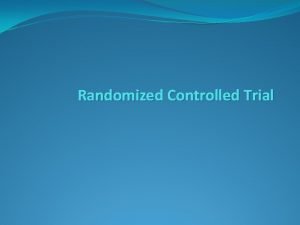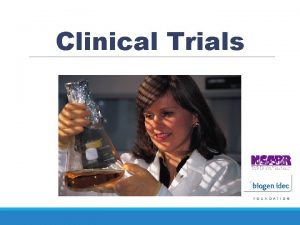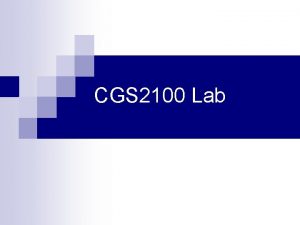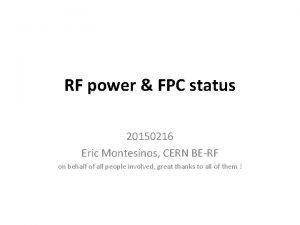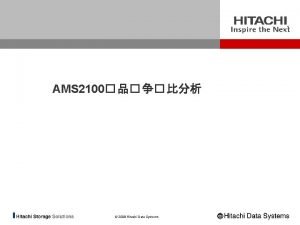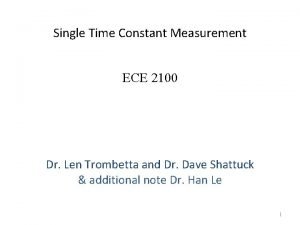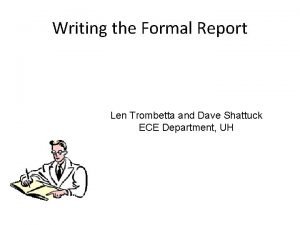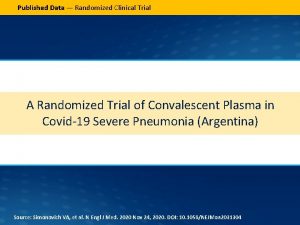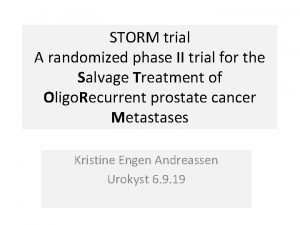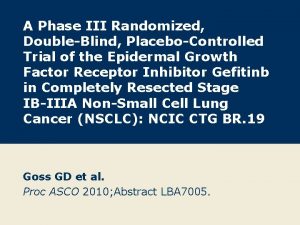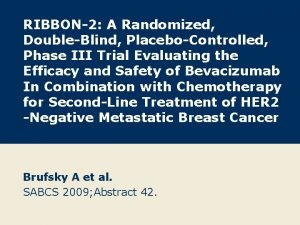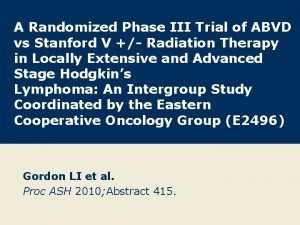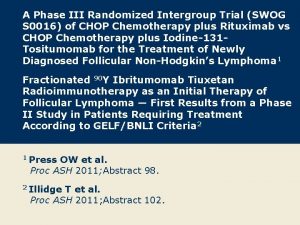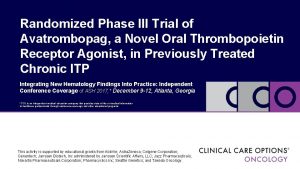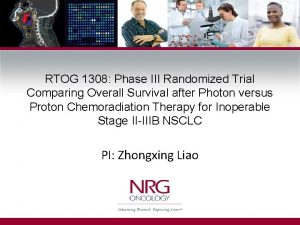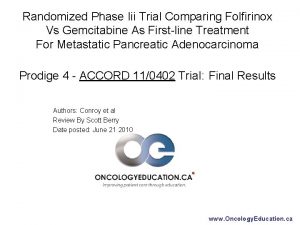E 2100 A Randomized Phase III Trial of

















- Slides: 17

E 2100 A Randomized Phase III Trial of Paclitaxel versus Paclitaxel plus Bevacizumab as First. Line Therapy for Locally Recurrent or Metastatic Breast Cancer KD Miller, M Wang, J Gralow, M Dickler, MA Cobleigh, EA Perez, TN Shenkier, NE Davidson Indiana University Cancer Center, Dana Farber Cancer Institute, Pudget Sound Oncology Consortium, Memorial Sloan Kettering Cancer Center, Rush-Presbyterian-St. Luke’s Medical Center, Mayo Clinic, British Columbia Cancer Agency, Vancouver Cancer Center, Johns Hopkins Oncology Center

Rationale • Tumor growth is dependent on angiogenesis • Bevacizumab is a humanized monoclonal antibody directed against VEGF • Recognizes all VEGF-A isoforms • Active in patients with refractory MBC • 9% response rate as monotherapy • Increases ORR but not PFS in combination with capecitabine • Greater activity expected in less heavily pre-treated patients

Study Design Stratify: • DFI < 24 mos. vs. > 24 mos. • < 3 vs. > 3 metastatic sites • Adjuvant chemotherapy yes vs. no • ER+ vs. ER- vs. ER unknown R A N D O M I Z E Paclitaxel + Bevacizumab Paclitaxel 28 -day cycle: Paclitaxel 90 mg/m 2 D 1, 8 and 15 Bevacizumab 10 mg/kg D 1 and 15

Key Eligibility Criteria • Locally recurrent or metastatic breast cancer – HER 2+ only if prior treatment with trastuzumab or contraindication • No prior chemo regimens for MBC – Adjuvant taxane allowed if DFI > 12 months • • ECOG PS 0 or 1 No anti-tumor therapy within 21 days No CNS mets (head CT or MR required) No significant proteinuria (> 500 mg/24 hr) • No therapeutic anticoagulation

Statistical Design Efficacy • Primary endpoint: Progression-Free Survival – 85% power for a 33% improvement • 6 vs. 8 months – One-sided type I error 2. 5% – Requires 650 eligible patients • Final analysis after 546 PFS events – Interim analyses after 270 and 425 events – Asymmetric boundaries to stop early either for demonstrated benefit or for lack of benefit – O-Brien-Fleming boundaries and repeated confidence interval analyses at each interim

Statistical Design - Safety • Type I event: Grade 4 hemorrhage or HTN – Acceptable rate: 1% • Type II event: Grade 3/4 thrombosis or embolism – Acceptable rate: 5%

Current Analysis • Study activated Dec 21, 2001 • Closed March 24, 2004 – 715 eligible patients • First planned interim analysis • Data cut-off February 9, 2005 • 355 events – Progression – 291 – Death without documented progression - 64

Patient Characteristics Treated Paclitaxel (n=350) 346 Pac. + Bev. (n=365) 365 Median age 55 (27 -85) 56 (29 -84) DFI < 24 months 41% > 3 sites 29% 28% Adjuvant chemo. 64% 65% ER+ 63% 64%

Response P<0. 0001 34. 3% 28. 2% 16. 4% 14. 2% 316 330 250 236

Progression Free Survival 1. 0 Pac. + Bev. 10. 97 months 0. 9 Paclitaxel PFS Proportion 0. 8 6. 11 months 0. 7 0. 6 0. 5 HR = 0. 498 (0. 401 -0. 618) 0. 4 Log Rank Test p<0. 001 0. 3 0. 2 0. 1 0. 0 0 10 20 Months 30

Overall Survival 1. 0 Pac. + Bev. 0. 9 Paclitaxel OS Proportion 0. 8 0. 7 0. 6 0. 5 0. 4 0. 3 0. 2 HR = 0. 674 (0. 495 -0. 917) 0. 1 Log Rank Test p=0. 01 0. 0 0 10 20 Months 30 40

Bevacizumab Toxicity NCI-CTC Grade 3 and 4 Paclitaxel (n=330) Pac. + Bev. (n=342) % Grade 3 4 HTN* 0 0 13 0. 9 1. 2 0 Bleeding 0 0 0. 6 0. 3 Proteinuria** 0 Thromboembolic NCI-CTC v 3. 0, worst per patient 0 0. 9 1. 5 *p<0. 0001; **p=0. 0004

Other Toxicities NCI-CTC Grade 3 and 4 Paclitaxel (n=330) Pac. + Bev. (n=342) % Grade 3 4 Neuropathy* 13. 6 0. 6 19. 9 0. 6 Fatigue 2. 7 0 4. 7 0. 3 Neutropenia 0 3 0. 9 4. 4 LVEF 0 0 0. 3 0 NCI-CTC v 3. 0, worst per patient *p=0. 01

Ongoing Correlative Studies • Quality of Life (FACT-B) • Circulating markers – Serum VCAM-1 – Urine VEGF • Analysis of primary tumor samples – VEGF expression

Conclusions and Future Directions • Addition of bevacizumab to paclitaxel – Significantly prolongs progression free survival – Increases objective response rate – Longer follow-up required to assess impact on OS • Further studies should – Explore the role of Bevacizumab in the adjuvant setting – Develop methods to identify patients who are most likely to benefit from VEGF-targeted therapies

Adjuvant Pilot Trial Rationale • Most successful use of anti-angiogenic therapy predicted to be in adjuvant setting – Require large trial for proof of concept • Limitations of metastatic trials – – Chronic therapy in only a few patients Different tolerance for toxicity Different metabolism (? ) Less concern for rare but potentially fatal toxicities

E 2104 Schema Arm A: dd. BAC >BT >B R E G I S T E R Doxorubicin 60 mg/m 2 plus Cyclophosphamide 600 mg/m 2 Bevacizumab 10 mg/kg every 14 days x 4 Paclitaxel 175 mg/m 2 Bevacizumab 10 mg/kg every 14 days x 4 Bevacizumab 10 mg/kg every 14 days x 18 Doxorubicin 60 mg/m 2 plus Cyclophosphamide 600 mg/m 2 every 14 days x 4 Paclitaxel 175 mg/m 2 Bevacizumab 10 mg/kg every 14 days x 4 Bevacizumab 10 mg/kg every 14 days x 22 Arm B: dd. AC >BT >B *Hormone therapy and radiation per standard care
 Advantage of randomized controlled trial
Advantage of randomized controlled trial Hamlet act iii scene iii
Hamlet act iii scene iii Phase 4 trial
Phase 4 trial Ece 2100
Ece 2100 Cgs 2100 ucf
Cgs 2100 ucf Wr-2100 waveguide
Wr-2100 waveguide Genamin kdmp inci
Genamin kdmp inci 2100-2008
2100-2008 Wr 2100 waveguide
Wr 2100 waveguide Weltbevölkerung
Weltbevölkerung Ece 2100
Ece 2100 Illorput 2000
Illorput 2000 Factors of 2100
Factors of 2100 Homework
Homework What is formal report
What is formal report Ipfp phase iii
Ipfp phase iii In a triangle connected source feeding a y connected load
In a triangle connected source feeding a y connected load Normal phase vs reverse phase chromatography
Normal phase vs reverse phase chromatography
